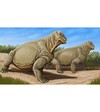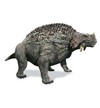Permo-Triassic Vertebrates Flashcards
(20 cards)
what are synapsids?
they are amniotes that came before dinosaurs. they are
divided into pelycosaurs and therapsids
which synapsid was first to appear?
Ophiacodon
- They were 1.5-3m long carnivores that fed on fish and tetrapods
- is a pelycosaur

what is the difference between pelycosaur and therapsids?
Therapsids evolved from a group of pelycosaurs called sphenacodonts.Therapsids became the dominant land animals in the Middle Permian, displacing the pelycosaurs.
what is a Caseid?
- -largest pelycosaur> 3m*
- -* large nostrils, no canine teeth and typically large rib cages to allow for digestion of large quantities of plant material

what a are sailed back synapsids?
what were the uses for sails?
2 grps, edaphasuarids and the sphenacodontids
The sails were thought to be a thermo regulator, had many blood vessels running through them
what are edaphasuarids?
The edaphasuarids were herbivores and had small peg-like teeth with jaws that allowed back and forwards movements

what are sphenacodontids?
- The sphenacodontids were medium to large carnivores, the largest and most famous was Dimetrodon

* The sails of these synapsids are made up extended neural spines
tell me about therapsids
- common in later Permian
- more mammal like hips and shoulders and jaws were changing, teeth reduced, and temporal fenestra becomes larger
include dinocephalians, dicynodonts, gorgonopsians, Therocephalia, Cynodonts,
what are dinocephalians?
- The dinocephalians were a major group from the Upper Permian of Russia and South Africa
- Contains both herbivores and carnivores
- Some of the herbivores become very large (5m)

what are dicynodonts?
- The dominate Late Permian herbivores belonged to the dicynodonts, as a group they barely survived the end Permian mass extinction
- They dominated the biomass of the era, with often a number of different species filling different herbivore niches in anyone area

what are gorgonopsians?
- The dominate carnivores of the Late Permian were the gorgonopsians
- Structurally they were fairly conservative group, most were medium sized (about 1m) with bodies looking similar to earlier carnivores
- They typically had enlarged canines similar to sabre-toothed cats

what are Therocephalia
•Another group of carnivorous therapsids, that lived from the Late Permian into the Triassic (when some became herbivores)

what are Cynodonts?
- The most advanced clade of synapsids
- It includes the mammals that evolved in the Triassic
- Even the latest Permian forms are beginning to look increasingly mammal-like
- In the Triassic cynodonts become more and more mammal like, the number and structure of the vertebral column become more mammal like
- Their hips and hindlimb structure changes allowing a more erect posture
- Finally the jaw structure become more mammal-like, with the dentary bone becoming ever larger
- The hinge structure in jaw also becomes more mammal-like

tell me about the evolution of mammals
•One of the key evolutionary transitions in the evolution of the mammals from earlier synapsids, is the reduction in the number of bones in the lower jaw and their migration into the inner ear
what is a diapsid and anapsid?
diapsid is a reptile of a large group characterized by the presence of two temporal openings in the skull, including the lizards, snakes, crocodiles, dinosaurs, and pterosaurs.
an anapsid is a reptile of a group characterized by the lack of temporal openings in the skull, including the turtles and their relatives.
what is a mesosaur?
- Mesosaurs are the first-known fully aquatic amniotes (Early Permian)
- They are small (1m) swimming amniotes, with long necks and flattened tails
- Their teeth suggest they ate small arthropods or fish
-anapsid

what are Protolophonids?
- Late Permian to Late Triassic anapsids
- Many had horns, looking at their teeth they were either herbivores or insectivores

what are Pareiasaurids?
- Large Late Permian herbivores
- Anapsids that ate soft vegetation, some have suggested that they are a sister group to the turtles, but this is highly debated

Coelurosauravus
- Overall low diversity until the Late Permian
- Most unusual was Coelurosauravus that used rod-like ribs for gliding

tell me about triassic diapsids
- The early Triassic started similar to the Permian being dominated by synapsids, but by the end of the period diaspids , including the dinosaurs, dominate terrestrial faunas
- The most important group of diapsids during this radiation were the archosaurs
- The group that includes the crocodiles, pterosaurs, birds and dinosaurs
- Most of the early ones were small and lightly built


